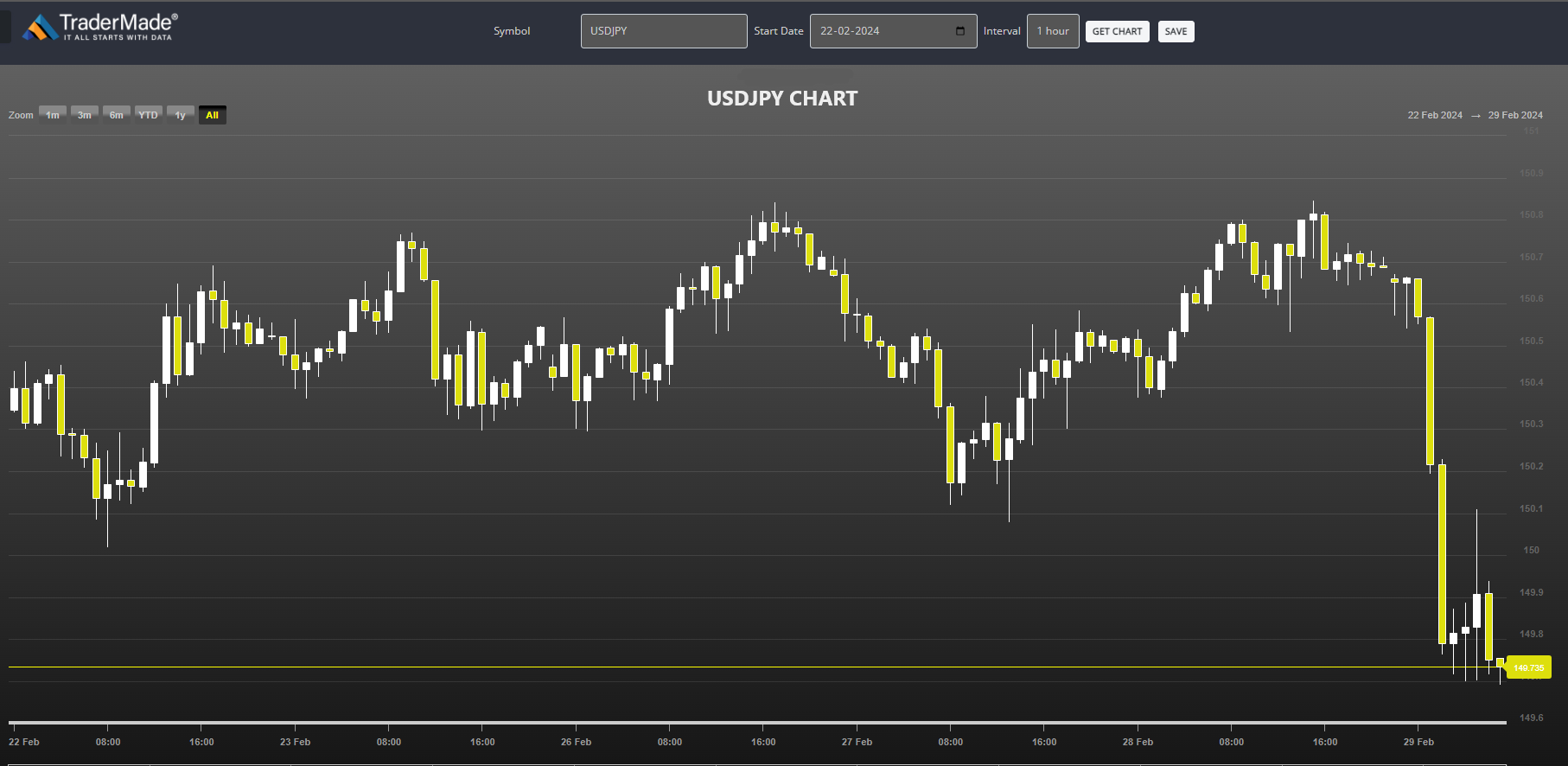
Yen Surges on BoJ Comments
London: 29 February 2024 (TraderMade): The Japanese Yen (JPY) experienced a surprising surge on Thursday, strengthening against major currencies like the US Dollar (USD) and Australian Dollar (AUD).
The Bank of Japan (BOJ) board member Hajime Takata hinted at a potential shift away from the central bank's ultra-loose monetary policy. This hawkish comment triggered an unexpected rally.
BOJ Hints at Potential Policy Shift
Takata's remarks, delivered on Thursday, sent shockwaves through the market. He suggested the BOJ might consider adopting "nimble and flexible approaches" towards exiting its current policy framework, which includes negative interest rates and yield curve control.
This comment fueled speculations that the central bank is finally preparing to move away from its ultra-accommodative stance, potentially paving the way for a future tightening cycle.
JPY Capitalizes on Shifting Sentiment
The Yen capitalized on the shift in market sentiment, appreciating against major currencies. The USD/JPY pair dipped below the psychological level of 150.00, reflecting a weakening Dollar against the Yen. Similarly, the AUD/JPY pair also traded lower, indicating a decline in the value of the Australian dollar compared to the Yen.
USDJPY Trajectory: Cautious Weakening Followed by a Sudden Dip
The USDJPY pair experienced a cautious weakening over the last four trading days, 26 to 29 February 2024, before taking a sharper downward turn on the previous day.

Here's a breakdown of the movement:
- 26 February: The pair opened slightly above 150.45 and remained largely confined within a narrow range throughout the day, closing at 150.71.
- 27 February: Similar to the previous day, the pair continued to trade sideways within a slightly tighter range, fluctuating between 150.08 and 150.71 before closing marginally lower at 150.52.
- 28 February: The pair exhibited a slightly more comprehensive range, with a high of 150.85 and a low of 150.37. Despite some intraday volatility, it closed marginally higher at 150.69.
- 29 February: The trajectory changed significantly on the last day. The pair opened near its previous close but experienced a sudden and notable decline throughout the day, reaching a low of 149.63 and closing at 149.65.
This price movement represents a drop of over 1% compared to the previous day's close and a decrease of around 0.70% compared to the opening price on 26 February.
US Inflation Data Remains the Key Catalyst
Despite the significant gains, the Yen's future trajectory remains uncertain. Market participants and economists await the crucial US Personal Consumption Expenditures (PCE) Price Index, scheduled for later Thursday.
The US PCE Price Index data point is considered the Federal Reserve's (Fed) preferred inflation gauge. It may impact the value of the US dollar significantly.
A stronger-than-expected reading: This scenario could bolster the USD, potentially limiting the Yen's upward momentum. If inflation continues to climb beyond expectations, the Fed might be inclined to maintain or even accelerate its tightening measures, leading to a stronger Dollar.
A weaker-than-expected reading: In this case, the USD could weaken further, potentially extending the Yen's recent gains. Lower inflation could give the BOJ more leeway to maintain its current policy stance or even consider further easing measures, potentially favoring the Yen.
Other Driving Factors
Mixed Japanese Economic Data
Recent economic data releases from Japan have painted a mixed picture. While retail sales rose higher than expected in January, industrial production experienced a significant decline. This diverse data could contribute to the uncertainty surrounding the BOJ's future policy decisions.
Gradual and Cautious Approach
Takata emphasized the need for "gradual steps" and cautioned against automatic responses when implementing monetary policy changes. This point suggests that even if the BOJ changes its stance, policy adjustments may be gradual and carefully calibrated.
Risk Aversion and Currency Intervention
The Yen also gained due to a generally softer risk tone in the market and a warning from Japan's vice finance minister about potential intervention against excessive currency volatility. These factors provided additional support to the rise of the Yen.
Looking Ahead
The market's focus remains firmly on the upcoming US inflation data. The data's release has the potential to significantly impact the global financial landscape, influencing not only Yen's trajectory but also broader market sentiment and currency valuations.
Beyond the PCE data, market participants and analysts will closely monitor further pronouncements from the BOJ and economic data releases from Japan and the US to gauge the future direction of the Yen and the broader global monetary policy landscape.


